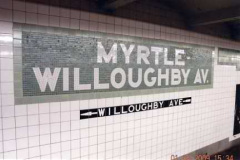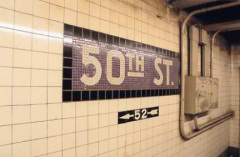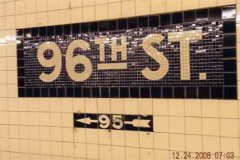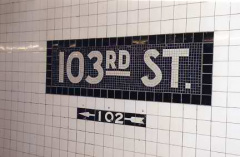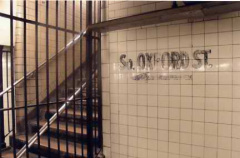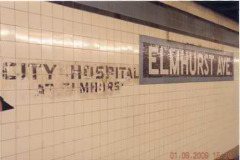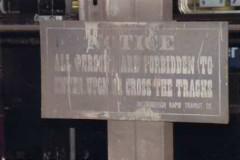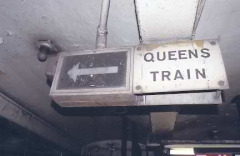As of February 2009 the subways are almost 105 years old and even the “newest” parts are over sixty years old. In that amount of time, there are bound to be outdated signs to exits that don’t exist anymore or landmarks that have been torn down. Some of this was deliberately done: plaques in some of the early BMT stations built in the 1910s call attention to objects or places that vanished years before, such as the bridge that took Broadway over the canal that Canal Street was later named for.
On this page, though, we’ll stick to misdirectionals or misspellings. There are a number around, but fewer than you’d think.
IND Errors
LEFT: Walton Street’s exit at the Flushing Avenue station on the G line cannot be reached by following the arrow. RIGHT: Want to go to the Willoughby Avenue exit on the G line at the Myrtle-Willoughby Avenue? Forget about it!
Nearly all the stations on the Independent have remained relatively unchanged since they were built (mostly between 1928 and 1940), with subway designer Squire Vickers substituting large, bold station nameplates for serifed mosaics (though closer inspection reveals that these plates, too, are made up of small tiles). Vickers also designed smaller, black and white directional signs pointing to the closest exits, with a simple arrow pointing in the direction the traveler should go. These signs featured a font quite like Copperplate, the font I use (along with Franklin Gothic) for FNY title cards. It wasn’t Copperplate, though; the font featured small, “vestigial” serifs much like Copperplate but it wasn’t quite the same. I wonder what the font name was.
Stepping into an IND station is like entering a time warp…you’re in 1935 again, that is, if you can ignore the new rolling stock and the aggressive installation of Helvetica’ed signs the MTA begun in 1970 or so.
LEFT: Exiting at South Portland Avenue at the Fulton Street station on the G line is only a wish. RIGHT: The Ralph Avenue station’s exit is at Ralph Avenue, not Howard Avenue.
There is a logic to the different tile colors in the IND: a series of color tiles are used at local stations, and change to another color after an express station is passed.
LEFT: The Bedford Avenue exit was closed sometime in the 1980s at the Nostrand Avenue station on the A and C lines. RIGHT: 163rd Street & Amsterdam cannot be directly reached from this station — the exit is at 161st. (the newer sign is helpful about that)
Despite IND stations’ seeming uniformity there are subtle changes as you proceed around the system. The Fulton Street line, for example, uses light and darker color tile, while the Eighth Avenue (right) places a black frame around the nameplate in its uptown stretch. This makes the subway walls resemble your webmaster’s bathroom tile scheme.
At right, we see one of the newer, modular subway signs, with black and white Helvetica, that began to take control in the early 1970s.
LEFT: The 56th Street staircase on the Northern Boulevard station on the R, V and sometimes the G has long been closed. RIGHT: The 50th Street station on the E, A and C (Eighth Avenue) line had an exit at 52nd street to accommodate the huge crowds at the old Madison Square Garden, which was replaced in 1968. That exit is no longer there.

The “Brodaway” error at Broadway on the G IND Crosstown Line is legendary in railfan circles, mainly because errors of this type are quite rare in original IND construction. In fact this may be the only one. We can see many more recent spelling errors on the gothamist page linked above; procedures have become more slipshod and in the rush to meet production deadlines, some errors are simply allowed to pass.
In this case a workman simply transposed the correct A and D tiles, and the error went unnoticed by inspectors. It has been there since the station opened in 1937.
LEFT: The 95th Street exit at 96th Street is open only in some people’s memories on the B and C line on Central Park West. RIGHT: Exiting at 63rd Street at the 65th Street station on the V, R and sometimes G lines? No way.
That 65th Station preserves Rowan Street signs (65th Street’s old name) and formerly had a sign directing riders to “Rockaway.” [see this FNY page] There is presently no easy connection at 65th Street to the A train, which goes to the Rockaway peninsula. However, prior to the Depression city planners envisioned an IND Second System that would build several new lines, including a combined subway/el that would hook up to the now-abandoned LIRR Rockaway Branch ands take passengers across Jamaica Bay. The A train was connected to it in the Fab Fifties. The old sign was placed when the builders were quite confident that the new lines would be built. But such confidence can be unfounded, as recent events have proven.
LEFT: Confusing, huh? It’s supposed at be a sign for the Van Wyck Blvd. on the Queens Boulevard line. The arrow points supposedly to Queens Boulevard. RIGHT: At first glance, the name “Briarwood” appears to be written in tile on the wall at the Van Wyck Blvd. station on the Queens Blvd. line. Actually, it’s a plaque!
A couple of interesting things going on here. For one thing, Van Wyck Boulevard no longer exists as a “boulevard.” Named for the first mayor of NYC after it became Greater NYC in 1898, Robert C. Van Wyck, an expressway was overbuilt on its route from the Grand Central Parkway to Idlewild _in sections between 1945 and 1950 and “Boulevard” became “Expressway.”
In photo right, the neighborhood the station serves has become known as “Briarwood” since the station was built in the 1930s, and a few years ago it was decided to install some signage in the station to reflect that. The new signs try to replicate the old IND font, but used Copperplate, which resembles it. They didn’t want to do individual tiles — too much work and craftsmanship involved — so a black plaque was used.
153rd Street & St. Nicholas Avenue cannot be directly reached from this station at 155th Street & St. Nicholas on the A and C.
This station is actually located at 156-157th Street and Frederick Douglass Boulevard. Why it was named 155th Street is a mystery. IND planners designed this station to handle huge crowds going to the Polo Grounds, the former home of the New York Giants until 1957 and the New York Mets in 1962 and 1963. Check out the entrance’s width! A spur of the 9th Avenue el also existed here to take riders across the Harlem River to Yankee Stadium until the 1950s. And, there’s no exit at 153rd.
You have to walk to the 103rd Street exit to get out of this station on Central Park West, Manhattan, not the 102nd Street exit, which is no longer in existence.
On Other Lines
During a more genteel era, restrooms were abundant in the subway system. Now restrooms, if you can find one and dare enter, are extremely rare. Men could use this facility on the express level at Nostrand Avenue on the A line (above left). Women’s and men’s facilities at the Fulton Street station on the 4 & 5 have been closed for years (above right, below left) IRT designers extended Beaux-Arts designs, with bas-reliefs and rosettes, to even the rest room facilities.
Below right: You have to admire the insouciance of IND planners in just calling the rest room facilities what they were. There’s a bracing lack of “hi-falutin-ness” in a handpainted sign in a public place that says “To Toilets.” I have attached a hard copy of this photo to a wall in your webmaster’s apartment in Lovable Little Neck that does, in fact, point to the toilet.
The MTA is in compliance with the ADA (Americans With Disabilities Act), although not 100%. Some old pre-ADA signs still linger on in some parts of the system. FNY found a few that are scattered around…
LEFT: Delancey Street on the F line hosts this 1930’s era sign. At times, the width of the beams the signs were placed on made interesting contractions necessary. RIGHT: Paint almost covers this one at 59th Street on the #1.
LEFT: 116 Street on the 1 is home to this sign. RIGHT: Paint and grime has made this one almost disappear at 137th Street & Broadway.
Renderings
As we’ve seen on that “To Toilets” sign, a precious few hand painted signs still exist around the system. Time has taken a toll on most of them.
LEFT: Grand Concourse trains can be gotten by following the arrow here at 145th Street on the A, B, C and D lines. RIGHT: Going to 145th Street? Follow this faded hand painted sign and you’ll be there.
Faded almost to nonexistence at Hanson Place, Greene Avenue and South Oxford Street exits.
These photos are in a rather dim area of these stations, and that reminds me that until the mid-to-late 1980s several IND stations on the present-day F/G lines (Carroll and Bergen Streets) and A (between Schermerhorn and East New York) were still lit with the same incandescent bulbs that they were built with in the 1930s. Only in the late 1980s did the MTA install brighter fluorescents.
Will one lose time searching for City Hospital at Elmhurst? It’s surprising that this painted sign has lasted so long. A second hand painted fading sign at the Elmhurst Avenue station on the Queens Boulevard line (it was apparently covered up but the substance is wearing off). City Hospital at Elmhurst is now Elmhurst Hospital Center.
LEFT: 50th Street station on the Eighth Avenue Line: Have to find St. Clare’s Hospital? You won’t find it under that name. It became a part of St. Vincent’s Midtown Hospital, which _shut down in August 2007. RIGHT: one of the oldest extant signs in the subways, this sign dates back to Hoyt Street’s opening in 1908.
It is still unwise to cross the tracks to get to the other platform.
This sign comes handy on the upper level at the 50th Street & 8th Avenue stop. The A and C stop on the upper level while the E stops on the lower level before veering east on 53rd Street towards Jamaica Center. This is an early 1970s use of the typefont Standard/Akzidenz, later _largely supplanted by Helvetica on subway signage.
You won’t have far to work to Methodist Hospital in Park Slope, Brooklyn at the 7th Avenue. The sign still does correctly what it has always done, since Methodist remains here.
A well preserved hand painted sign points you to Queensboro Hall (officially, Queens Borough Hall) at the Union Turnpike station on the E and F lines.
A very eaily missed sign is still visible facing the downtown platform on the 4 and 5 route on the newly renovated Wall Street station.
An antique sign on the upper level of the Queens bound platform on the A and C at Nostrand Avenue, Brooklyn.
Page completed February 14, 2009. Photographs and captions by Gary Fonville.
©2009 FNY



